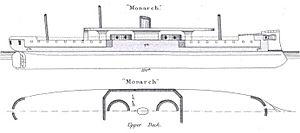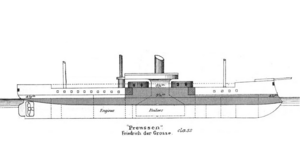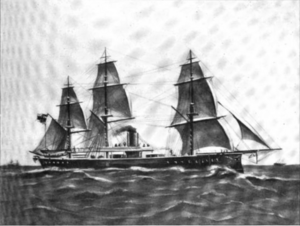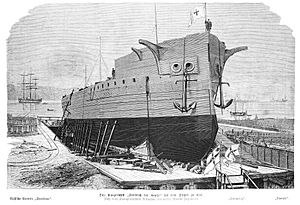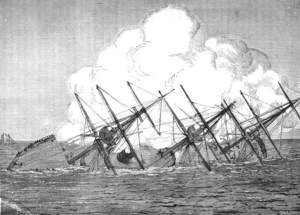Preussen-class ironclad facts for kids
The Preussen class was a group of three powerful armored ships built for the German Imperial Navy in the early 1870s. These ships were called armored frigates, which means they were large warships protected by heavy armor. Their main job was to defend Germany's coastlines.
The first ship, SMS Preussen, was started in 1871 and launched in 1873. SMS Friedrich der Grosse also began in 1871 and was launched in 1874. SMS Grosser Kurfürst was actually the first one started, in 1869, but it was the last to be finished, launching in 1875. All three ships joined the fleet starting in 1876.
Sadly, SMS Grosser Kurfürst was lost in 1878 during a training exercise. It accidentally crashed with another German ship, SMS König Wilhelm, and sank quickly. The other two ships, SMS Preussen and SMS Friedrich der Grosse, served in the fleet until the 1890s. After that, they were used for simpler jobs, like being harbor ships or even floating coal storage. They were eventually taken apart for scrap metal after World War I, in 1919 and 1920.
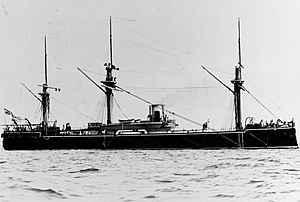
Preussen in 1887
|
|
Quick facts for kids Class overview |
|
|---|---|
| Builders: |
|
| Operators: | |
| Preceded by: | SMS Hansa |
| Succeeded by: | Kaiser class |
| Built: | 1868–1878 |
| In commission: | 1876–1894 |
| Completed: | 3 |
| Lost: | 1 |
| Retired: | 2 |
| General characteristics | |
| Type | Turret ship |
| Displacement | |
| Length | 96.59 m (316 ft 11 in) |
| Beam | 16.30 m (53 ft 6 in) |
| Draft | 7.11 m (23 ft 4 in) |
| Installed power | |
| Propulsion | |
| Sail plan | Full-rigged ship |
| Speed | 14 knots (26 km/h; 16 mph) |
| Range | 1,690 nmi (3,130 km) at 10 kn (19 km/h) |
| Complement |
|
| Armament |
|
| Armor |
|
Contents
Designing the Preussen Class Ships
In 1867, the German government decided to build a strong navy. Their plan was to have sixteen ironclad warships by 1877. These ships were needed to protect German ports. During a war in 1864, Danish ships had blocked German ports, and Germany wanted to prevent that from happening again.
At first, Germany bought some ironclads from other countries. Then, in 1868, they started building their own warships. The Preussen class was special because it was the first group of ships designed to be exactly alike for the German fleet.
The design for the Preussen class was created in 1868. The main designer, Carl Elbertzhagen, first planned a ship with guns inside a protected room called a casemate. However, while the first ship, SMS Grosser Kurfürst, was being built, Elbertzhagen changed his mind.
He decided to build a "turret ship" instead. This new design had two spinning gun turrets, like those on the British ship HMS Monarch. These heavy turrets had to be placed low on the ship to keep it stable. This meant the ship's sides were low to the water, which could make it hard to sail in rough seas. To fix this, the ships had raised sections at the front and back. They also had special hinged walls that could be raised when sailing and lowered when the guns needed to be used. This change in design caused big delays in building SMS Grosser Kurfürst.
Ship Features and Performance
The Preussen-class ships were about 96.59 meters (316 feet 11 inches) long. They were 16.30 meters (53 feet 6 inches) wide. When fully loaded, they weighed about 7,718 tons. Their hulls were made of iron frames covered with iron plates, which were backed by strong teak wood. Each ship had twelve watertight sections and a double bottom for extra safety.
The German navy thought these ships were good at sea. They responded well to steering commands and moved smoothly. They could turn sharply but were a bit slow when using their sails. Each ship had a crew of 46 officers and 454 sailors. They also carried several smaller boats, like launches and dinghies.
The ships were powered by one large steam engine. Six coal-fired boilers provided the steam for the engine. These boilers sent their smoke up a single, large funnel in the middle of the ship. The ships could reach a top speed of 14 knots (about 26 kilometers per hour or 16 miles per hour). They could carry enough coal to travel about 1,690 nautical miles (3,130 kilometers or 1,940 miles) at a slower speed of 10 knots. They also had full sailing rigs, meaning they could use sails to move.
Guns and Protection
The main weapons on the Preussen-class ships were four 26 cm (10.2 inch) guns. These guns were placed in two spinning turrets in the middle of the ship. Each turret had two guns. These guns could fire shells up to 5,000 meters (5,468 yards).
Because the raised sections at the front and back blocked the main guns from firing directly forward or backward, the ships also had two smaller 17 cm (6.7 inch) guns. One was at the front and one at the back. These guns could also fire up to 5,000 meters.
Between 1889 and 1891, SMS Preussen and SMS Friedrich der Grosse were updated. They received more modern, faster-firing guns. They also had five 35 cm (13.8 inch) torpedo tubes added. Torpedoes are underwater weapons that can hit other ships.
The ships' armor was made of tough wrought iron with thick teak wood behind it. The main armor belt around the ship's waterline was 203 mm (8 inches) thick at the top. Below that, it varied from 102 mm to 229 mm (4 to 9 inches) thick. The gun turrets had armor that was 203 mm to 254 mm (8 to 10 inches) thick. The thickest armor was on the front of the turrets, where they were most likely to be hit.
Building the Ships
SMS Grosser Kurfürst was the first ship laid down in 1869. The other two ships started in 1871. Grosser Kurfürst and Friedrich der Grosse were built by new, less experienced shipyards owned by the German government. SMS Preussen was built by a private company called AG Vulcan.
Even though Grosser Kurfürst started two years before its sister ships, it was finished last. This was because of the design changes and the shipyards' lack of experience. It took ten years to build Grosser Kurfürst, compared to eight years for Friedrich der Grosse and only six years for Preussen.
| Ship Name | Builder | Laid Down | Launched | Commissioned |
|---|---|---|---|---|
| Grosser Kurfürst | Kaiserliche Werft, Wilhelmshaven | 1869 | 17 September 1875 | 6 May 1878 |
| Preussen | AG Vulcan, Stettin | 1871 | 22 November 1873 | 4 July 1876 |
| Friedrich der Grosse | Kaiserliche Werft, Kiel | 1871 | 20 September 1874 | 22 November 1877 |
Ship Service History
After SMS Preussen was finished in July 1876, it joined the German fleet. In 1877, it was sent with a group of ships to the Mediterranean Sea. There was trouble in the Ottoman Empire because of a war, and German citizens living there needed protection. The ships visited ports in July 1877, but everything seemed calm. The squadron then sailed around the Mediterranean before returning to Germany in October.
By May 1878, all three Preussen-class ships were ready for the yearly summer training. They were joined by another large armored ship, SMS König Wilhelm. However, SMS Friedrich der Grosse couldn't join because it ran aground (got stuck) near Nyborg.
While sailing in the English Channel on May 31, SMS König Wilhelm accidentally crashed into SMS Grosser Kurfürst. Grosser Kurfürst sank very quickly, and between 269 and 284 sailors lost their lives. This accident led to many investigations. The commanders involved were found not guilty, but the event caused a lot of arguments within the navy.
SMS Preussen and SMS Friedrich der Grosse continued to serve in the armored squadron for training cruises from 1879 to 1883. After that, they were put into reserve, meaning they were kept ready but not actively used, as newer ships took their place.
In 1889, the two ships were brought back into service for special cruises. These included a visit to Great Britain and a trip around the Mediterranean Sea in 1889–1890. They continued their training duties into the early 1890s. SMS Preussen stopped active service in 1891, and SMS Friedrich der Grosse followed at the end of 1894.
After leaving active duty, both ships were used for simpler jobs. They became harbor ships and later served as floating storage for coal, supplying fuel to smaller torpedo boats. Both ships were eventually sold for scrap metal in 1919, after World War I ended. They were completely taken apart by 1920.


